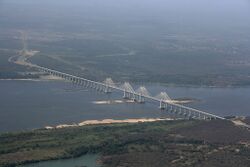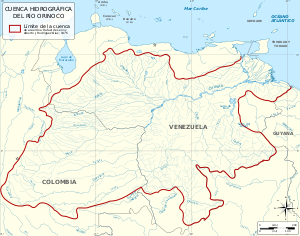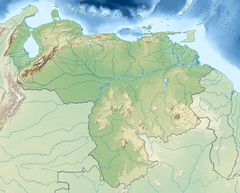أورينوكو
| Orinoco River Río Orinoco | |
|---|---|
 Orinoquia Bridge near Ciudad Guayana, Venezuela | |
 Orinoco's drainage basin | |
| الموقع | |
| Countries | |
| Region | South America |
| السمات الطبيعية | |
| المنبع | Hydrological source (Main stem) |
| ⁃ الموقع | Cerro Delgado-Chalbaud, Parima Mountains, Venezuela |
| ⁃ الإحداثيات | 2°19′05″N 63°21′42″W / 2.31806°N 63.36167°W |
| ⁃ المنسوب | 1,047 m (3,435 ft) |
| 2nd source | Geographical source (Orinoco-Guaviare-Guayabero-Papamene-Sorrento) |
| ⁃ الموقع | Headwaters of Rio Sorrento, Paramo de Sumapaz, Meta, Colombia |
| ⁃ الإحداثيات | 3°34′2″N 74°31′23″W / 3.56722°N 74.52306°W (approximately) |
| ⁃ المنسوب | 3,530 m (11,580 ft) (approximately) |
| المصب | Delta Amacuro |
- الموقع | Atlantic Ocean, Venezuela |
- الإحداثيات | 8°37′N 62°15′W / 8.617°N 62.250°WCoordinates: 8°37′N 62°15′W / 8.617°N 62.250°W[1] |
- المنسوب | 0 m (0 ft) |
| الطول | 2,250 km (1,400 mi) |
| مساحة الحوض | 989,000 km2 (382,000 sq mi) |
| العمق | |
| - الأقصى | 100 m (330 ft) |
| التدفق | |
| ⁃ الموقع | Orinoco Delta, Atlantic Ocean |
| ⁃ المتوسط | (Period of data: 1926-2011)37,740 m3/s (1,333,000 cu ft/s)[2] |
| ⁃ أدنى تدفق | 21,000 m3/s (740,000 cu ft/s) |
| ⁃ أقصى تدفق | 54,000 m3/s (1,900,000 cu ft/s) |
| التدفق | |
| ⁃ الموقع | Ciudad Bolívar, Venezuela (Basin size: 836,000 km2 (323,000 sq mi)) |
| ⁃ المتوسط | ( Period: 1926-2011)32,760 m3/s (1,157,000 cu ft/s)[3] |
| التدفق | |
| ⁃ الموقع | Puerto Ayacucho, Venezuela ( Basin size: 342,000 km2 (132,000 sq mi)) |
| ⁃ المتوسط | (Period: 1926-2011)16,182 m3/s (571,500 cu ft/s)[4] |
| التدفق | |
| ⁃ الموقع | Masagua, Colombia (Basin size: 101,000 km2 (39,000 sq mi)) |
| ⁃ المتوسط | 4,400 m3/s (160,000 cu ft/s) |
| التدفق | |
| ⁃ الموقع | Tama Tama, Venezuela (Basin size: 37,870 km2 (14,620 sq mi) |
| ⁃ المتوسط | 1,400 m3/s (49,000 cu ft/s) |
| سمات الحوض | |
| الروافد | |
| - اليسرى | Casiquiare, Atabapo, Guaviare, Vichada, Tomo, Cinaruco, Capanaparo, Meta, Arauca, Apure, Guárico |
| - اليمنى | Mavaca, Sipapo, Ocamo, Ventuari, Suapure, Parguaza, Caura, Cuchivero, Aro, Caroní |
 | |
يجري نهر اورينوكو في أمريكا الجنوبية وطوله 2,066 كم وله منبعان معروفان، كلاهما في هضاب پاريما في ڤنزويلا، قرب حدودها مع البرازيل. يجري النهر باتجاه الشمال نحو كولومبيا، ويشكل الحد الفاصل بين كولومبيا وڤنزويلا، ثم ينعطف النهر شرقًا. وقبل أن يصل إلى شاطئ البحر بمسافة 180 كم، يتفرع إلى عدة قنوات.
تستطيع بواخر المحيط الصغيرة أن تُبحر داخل النهر بعكس اتجاه التيار مسافة 418 كم من مصب النهر. كما تستطيع السفن أن تستخدم النهر مسافة 800 كم تقريبًا وراء منحدرات ميبوريس وايتيوريس. وتعتبر مدينة سيوداد بوليڤار مركزًا تجاريًا على نهر أورينوكو. وتبحر السفن التجارية بين مدينتي ترينيداد وسيوداد بوليڤار معظم أيام السنة. والفروع الرئيسية للنهر هي أپوره وكاروني ومـِتا وگواڤياره. وتبلغ أطوال النهر مع روافده الصالحة للملاحة 6,920 كم.
أصل الاسم
The river's name is derived from the Warao term for "a place to paddle", itself derived from the terms güiri (paddle) and noko (place) i.e. a navigable place.[5][6]
تاريخ
The mouth of the Orinoco River at the Atlantic Ocean was documented by Christopher Columbus on 1 August 1498, during his third voyage. Its source at the Cerro Delgado–Chalbaud, in the Parima range, was not explored until 453 years later, in 1951. The source, near the Venezuelan–Brazilian border, at 1,047 metres (3,435 ft) above sea level (2°19′05″N 63°21′42″W / 2.31806°N 63.36167°W), was explored in 1951 by a joint French-Venezuelan expedition.
The Orinoco, as well as its tributaries in the eastern llanos such as the Apure and Meta, were explored in the 16th century by German expeditions under Ambrosius Ehinger and his successors. In 1531, starting at the principal outlet in the delta, the Boca de Navios, Diego de Ordaz sailed up the river to the Meta. Antonio de Berrio sailed down the Casanare to the Meta, and then down the Orinoco River and back to Coro. In 1595, after capturing de Berrio to obtain information while conducting an expedition to find the fabled city of El Dorado, the Englishman Sir Walter Raleigh sailed down the river, reaching the savanna country.
Alexander von Humboldt explored the basin in 1800, reporting on the pink river dolphins. He published extensively on the river's flora and fauna.[7]
The sources of the Orinoco River, located at Cerro Carlos Delgado Chalbaud (2º19’05” N, 63º21’42” W), were discovered in 1951 by the French-Venezuelan expedition that went back and explored the Upper Orinoco course to the Sierra Parima near the border with Brasil, headed by Venezuelan army officer Frank Risquez Iribarren. [8][9]
The first bridge across the Orinoco River, the Angostura Bridge at Ciudad Bolívar, Venezuela, was completed in 1967.[10]
In 1968, an expedition was set off by National Geographic and Hovercraft from Manaus in Brazil to Port Of Spain (Trinidad). Aboard of a SR.N6 hoverwork the expedicionaries followed the Negro river upstream to where it is joined by the Casiquiare canal in the border between Colombia and Venezuela. After following the Casiquiare to the Orinoco River they hovered thru perilous Rapids of Maipures and Atures. The Orinoco was then traversed down to its mouths in the Gulf of Paria and then to Port of Spain. The primary purpose of the expedition was filming for the BBC series "The World About Us" the episode "The Last Great Journey on Earth from Amazon to Orinoco by Hovercraft", aired in 1970, and demonstrate the abilities of a hovercraft, thereby promoting sales of this British invention.
The first powerline crossing of the Orinoco River was completed in 1981 for an 800 kV TL single span of 1,200 metres (3,900 ft) using two towers 110 metres (360 ft) tall.[11] In 1992, an overhead power line crossing for two 400 kV-circuits was completed just west of Morocure (between the cities of Ciudad Bolívar and Ciudad Guayana), north of the confluence of Routes 1 and 19. It had three towers, and the two spans measured 2,161 metres (7,090 ft) and 2,537 metres (8,323 ft), respectively.[11][12][13][14]
In 2006, a second bridge, known as the Orinoquia Bridge, was completed near Ciudad Guayana, Venezuela.[بحاجة لمصدر]
الجغرافيا
الأنهار الرئيسية في حوض اورينوكو

- Apure: from Venezuela through the east into the Orinoco
- Arauca: from Colombia to Venezuela east into the Orinoco
- Atabapo: from the Guiana Highlands of Venezuela north into the Orinoco
- Caroní: from the Guiana Highlands of Venezuela north into the Orinoco
- Casiquiare canal: in SE Venezuela, a distributary from the Orinoco flowing west to the Negro River, a major affluent to the Amazon
- Caura: from eastern Venezuela (Guiana Highlands) north into the Orinoco
- Guaviare: from Colombia east into the Orinoco
- Inírida: from Colombia southeast into the Guaviare.
- Meta: from Colombia, border with Venezuela east into the Orinoco
- Ventuari: from eastern Venezuela (the Guiana Highlands) southwest into the Orinoco
- Vichada: from Colombia east into the Orinoco
Economic activity
The river is navigable for most of its length, and dredging enables ocean ships to go as far as Ciudad Bolívar, at the confluence of the Caroní River, 435 kilometres (270 mi) upstream. River steamers carry cargo as far as Puerto Ayacucho and the Atures Rapids.
El Florero iron mine
In 1926, a Venezuelan mining inspector found one of the richest iron ore deposits near the Orinoco delta, south of the city of San Felix on a mountain named El Florero. Full-scale mining of the ore deposits began after World War II, by a conglomerate of Venezuelan firms and US steel companies. At the start in the early 1950s, about 10,000 tons of ore-bearing soil was mined per day.[16]
Tar sands
The Orinoco River deposits also contain extensive tar sands in the Orinoco oil belt, which may be a source of future oil production.[17]
Eastern Venezuelan basin

Encompassing the states of Anzoategui-Guarico and Monagas states, the Interior Range forms the northern boundary and the Guayana Shield the southern boundary.[18] Maturin forms the eastern subbasin and Guarico forms the western subbasin.[18] The El Furrial oil field was discovered in 1978, producing from late Oligocene shallow marine sandstones in an overthrusted foreland basin.[18]
المصادر
- الموسوعة المعرفية الشاملة
- Stark, James H. 1897. Stark's Guide-Book and History of Trinidad including Tobago, Granada, and St. Vincent; also a trip up the Orinoco and a description of the great Venezuelan Pitch Lake. Boston, James H. Stark, publisher; London, Sampson Low, Marston & Company. (This book has an excellent description of a trip up the Orinoco as far as سيوداد بوليڤار and a detailed description of the Venezuelan Pitch Lake situated on the western side of the Gulf of Paria opposite.)
- MacKee, E.D., Nordin, C.F. and D. Perez-Hernandez (1998). "The Waters and Sediments of the Rio Orinoco and its major Tributaries, Venezuela and Colombia." United States Geological Survey water-supply paper, ISSN 0083; 2326/A-B. Washington: United States Government Printing Office.
- Weibezahn, F.H., Haymara, A. and M.W. Lewis (1990). The Orinoco River as an ecosystem. Caracas: Universidad Simon Bolivar.
- Rawlins, C.B. (1999). The Orinoco River. New York: Franklin Watts.
وصلات خارجية
- "Cuenca del Orinoco" ("The Orinoco Basin"), from the Spanish Wikipedia
- "The Orinico Heavy Oil Belt In Venezuela (or Heavy Oil to the Rescue?)" Department of Earth Science, Rice University
المراجع
- ^ Orinoco River at GEOnet Names Server
- ^ José Rafael, Córdova; Marcelo González, Sanabria. "La geografía del agua" (PDF).
- ^ José Rafael, Córdova; Marcelo González, Sanabria. "La geografía del agua" (PDF).
- ^ José Rafael, Córdova; Marcelo González, Sanabria. "La geografía del agua" (PDF).
- ^ "Orinoco River". Encyclopaedia Britannica. Retrieved 11 April 2020.
- ^ "Orinoco". Diccionario Etimológico Español en Línea. Retrieved 11 April 2020.
- ^ Helferich, Gerard (2004) Humboldt's Cosmos: Alexander von Humboldt and the Latin American Journey that Changed the Way We See the World, Gotham Books, New York, ISBN 1-59240-052-3.
- ^ Alberto Contramaestre Torres. Expedición a las fuentes del Orinoco. Caracas, 1954.
- ^ Pablo J. Anduce. Shailili-Ko. Descubrimiento de las fuentes del Orinoco. Caracas: Talleres Gráficos Ilustraciones S. A., 1960
- ^ Scott, R. (2001). In the Wake of Tacoma: Suspension Bridges and the Quest for Aerodynamic Stability. American Society of Civil Engineers. p. 184. ISBN 9780784470732. Retrieved 2015-04-13.
- ^ أ ب "Experience". SAE Power Lines. Archived from the original on 2015-08-02. Retrieved 2015-10-13.
- ^ "Critical Path" (PDF). PEI. June 2005. pp. 105–111, page 107. Archived from the original (PDF) on 23 September 2006.
- ^ "Pylons of the Orinoco High-Voltage Crossing". International Database for Civil and Structural Engineering. Archived from the original on 4 March 2016. Retrieved 13 October 2015.
- ^ "Orinoco Powerline Crossing". Skyscraper Source Media Inc. Archived from the original on 5 March 2016.
- ^ "Ciudad Guayana, Venezuela : Image of the Day". earthobservatory.nasa.gov. Retrieved 2009-10-31.
- ^ "Venezuela's Magnetic Mountain" Popular Mechanics, July 1949
- ^ Forero, Juan (1 يونيو 2006). "For Venezuela, A Treasure In Oil Sludge". The New York Times. Vol. 155, no. 53597. pp. C1–C6. Archived from the original on 20 December 2016.
- ^ أ ب ت Prieto, R., Valdes, G., 1992, El Furrial Oil Field, In Giant Oil and Gas Fields of the Decade, 1978–1988, AAPG Memoir 54, Halbouty, M.T., editor, Tulsa: American Association of Petroleum Geologists, ISBN 0891813330
- Short description is different from Wikidata
- Articles with hatnote templates targeting a nonexistent page
- Coordinates on Wikidata
- Articles with unsourced statements from February 2016
- أنهار كولومبيا
- أنهار ڤنزويلا
- أنهار دولية في أمريكا الجنوبية
- حدود ڤنزويلا-كولومبيا
- حوض أورينوكو
- أنهار وممرات مائية مُكرَّكة
- صفحات مع الخرائط




